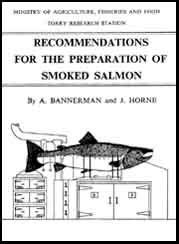Contents Index

Accompanying Notes
Table of Contents
MINISTRY OF AGRICULTURE, FISHERIES AND FOOD
TORRY RESEARCH STATION
By A. BANNERMAN and J. HORNE
TORRY ADVISORY NOTE No. 5 (revised)
Crown copyright material is reproduced with the permission of the Controller of Her Majesty's Stationery Office.
This electronic document has been scanned using optical character recognition (OCR) software and careful manual recorrection. Even if the quality of digitalisation is high, the FAO declines all responsibility for any discrepancies that may exist between the present document and its original printed version.
Provides practical advice on selection, gutting, filleting, dry-salting, brining, cold smoking, packaging and storage of smoked salmon and gives information on brine strength, smoking time, temperature and weight loss. Also see Note 90.
This Note was published before the rapid increase in availability of farmed salmon. The fat content of the salmon flesh should be no greater than 15% at harvest for fish that is to be smoked and sliced. Modern smoking and salting methods are used primarily to flavour the product and these milder processes contribute only a limited preservative effect resulting in only a small extension of shelf-life compared with that of the raw fish. Since cold smoked salmon is usually eaten without any cooking, the salt concentration in the water phase of the product and proper refrigeration of the product below 5°C along the whole chill chain from producer to consumer are critical factors for product safety. The minimum salt concentration in the water phase of the product should be 3.5% (weight by weight), as measured in the thickest part of the fillet. Further information about the potential botulism hazard and the important distinction between salt content of the flesh and salt concentration in the water phase can be found in Notes 22, 66, 74 and 82 respectively. The following practices should be part of process control:
(FAO in partnership with Support unit for International Fisheries and Aquatic Research, SIFAR, 2001).
Introduction
The raw material
Preparation
Salting
Draining
Smoking
Packing and storage
Contents Index